ECO mode TOYOTA TACOMA 2011 (in English) Owner's Manual
[x] Cancel search | Manufacturer: TOYOTA, Model Year: 2011, Model line: TACOMA, Model: TOYOTA TACOMA 2011Pages: 548, PDF Size: 9.84 MB
Page 431 of 548
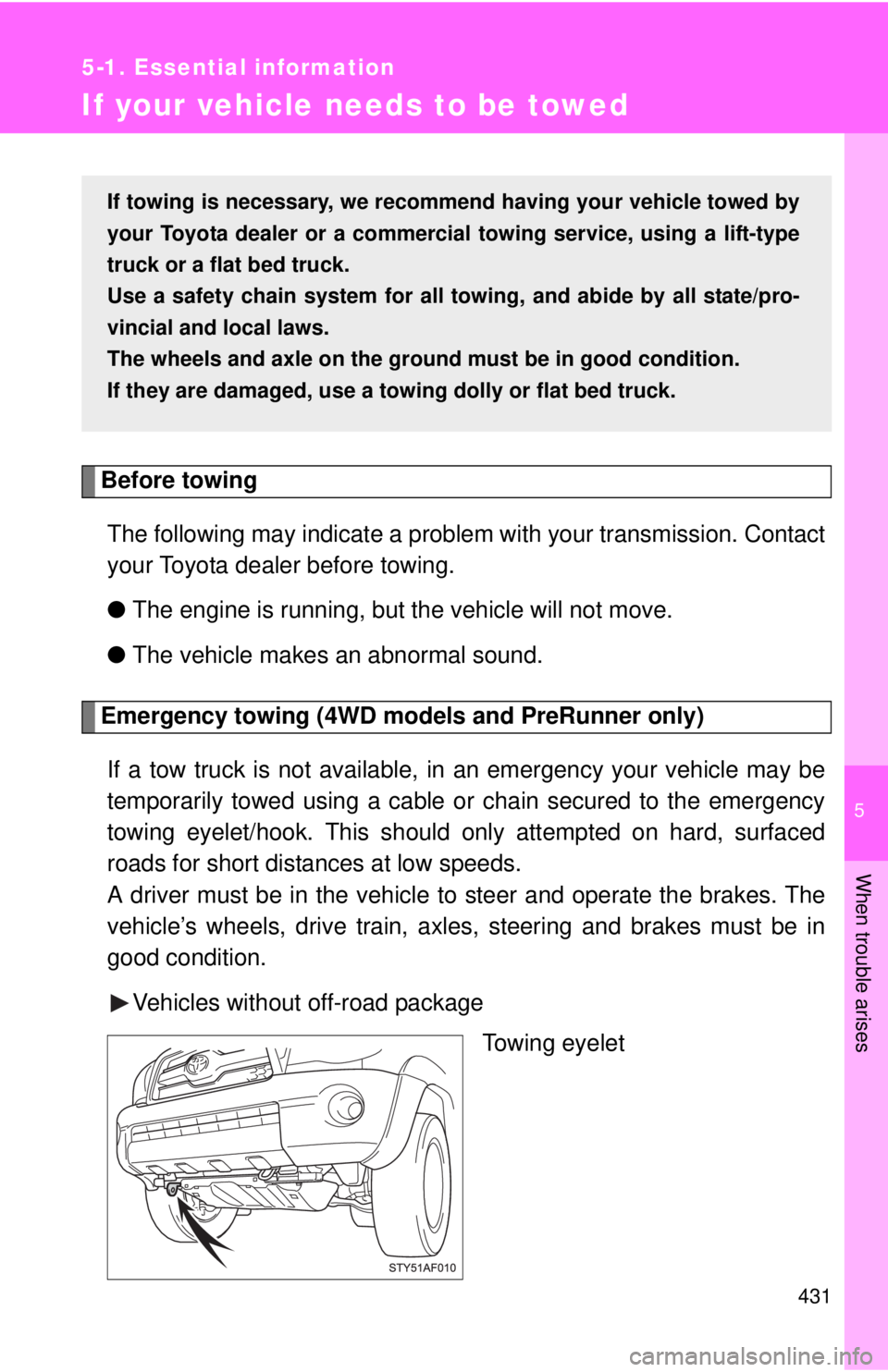
5
When trouble arises
431
5-1. Essential information
If your vehicle needs to be towed
Before towingThe following may indicate a problem with your transmission. Contact
your Toyota dealer before towing.
● The engine is running, but the vehicle will not move.
● The vehicle makes an abnormal sound.
Emergency towing (4WD models and PreRunner only)
If a tow truck is not available, in an emergency your vehicle may be
temporarily towed using a cable or chain secured to the emergency
towing eyelet/hook. This should only attempted on hard, surfaced
roads for short distances at low speeds.
A driver must be in the vehicle to steer and operate the brakes. The
vehicle’s wheels, drive train, axles, steering and brakes must be in
good condition.
Vehicles without off-road package Towing eyelet
If towing is necessary, we recommend having your vehicle towed by
your Toyota dealer or a commerci al towing service, using a lift-type
truck or a flat bed truck.
Use a safety chain system for all to wing, and abide by all state/pro-
vincial and local laws.
The wheels and axle on the groun d must be in good condition.
If they are damaged, use a towing dolly or flat bed truck.
Page 434 of 548
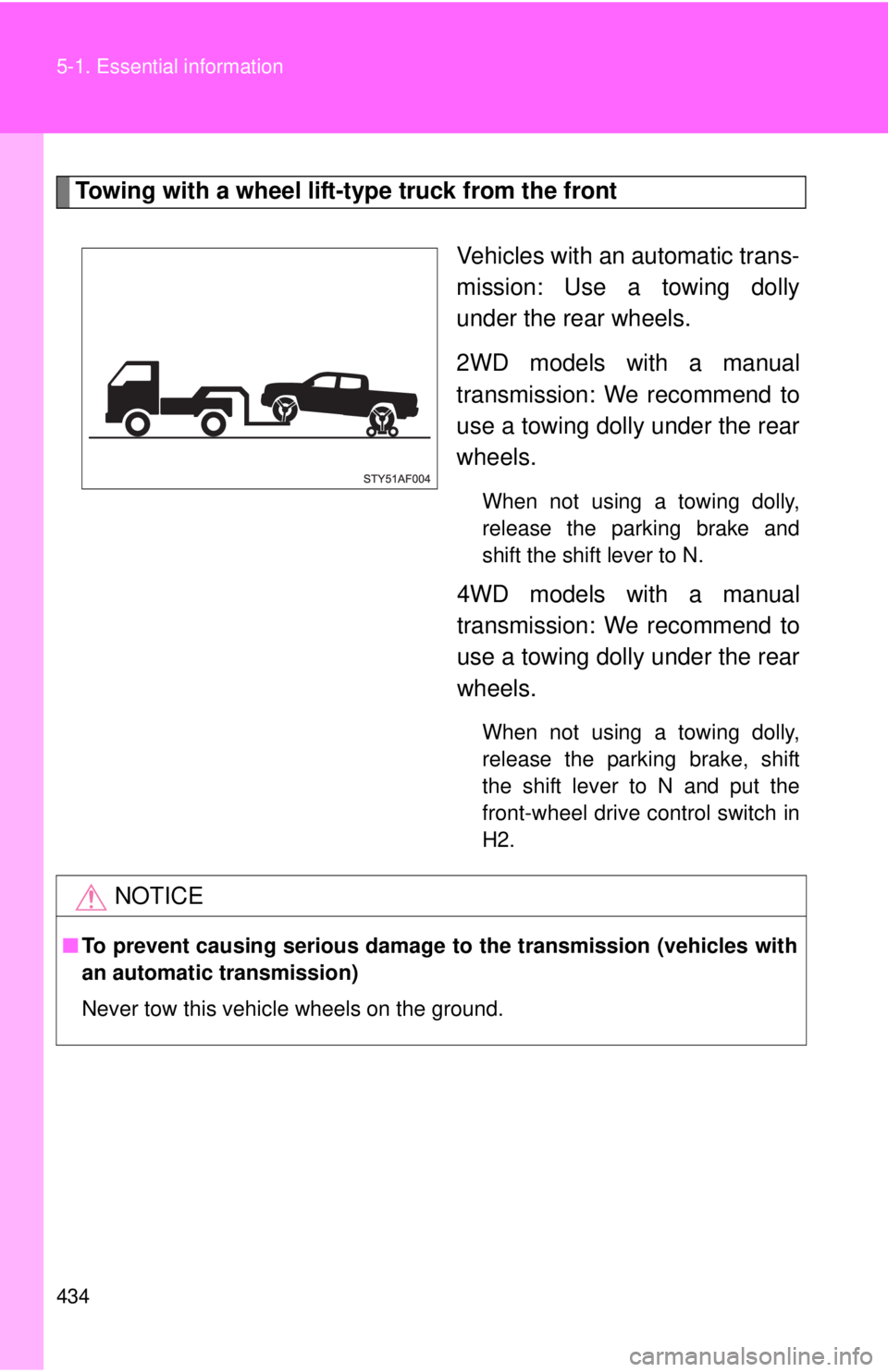
434 5-1. Essential information
Towing with a wheel lift-type truck from the frontVehicles with an automatic trans-
mission: Use a towing dolly
under the rear wheels.
2WD models with a manual
transmission: We recommend to
use a towing dolly under the rear
wheels.
When not using a towing dolly,
release the parking brake and
shift the shift lever to N.
4WD models with a manual
transmission: We recommend to
use a towing dolly under the rear
wheels.
When not using a towing dolly,
release the parking brake, shift
the shift lever to N and put the
front-wheel drive control switch in
H2.
NOTICE
■To prevent causing serious damage to the transmission (vehicles with
an automatic transmission)
Never tow this vehicle wheels on the ground.
Page 435 of 548
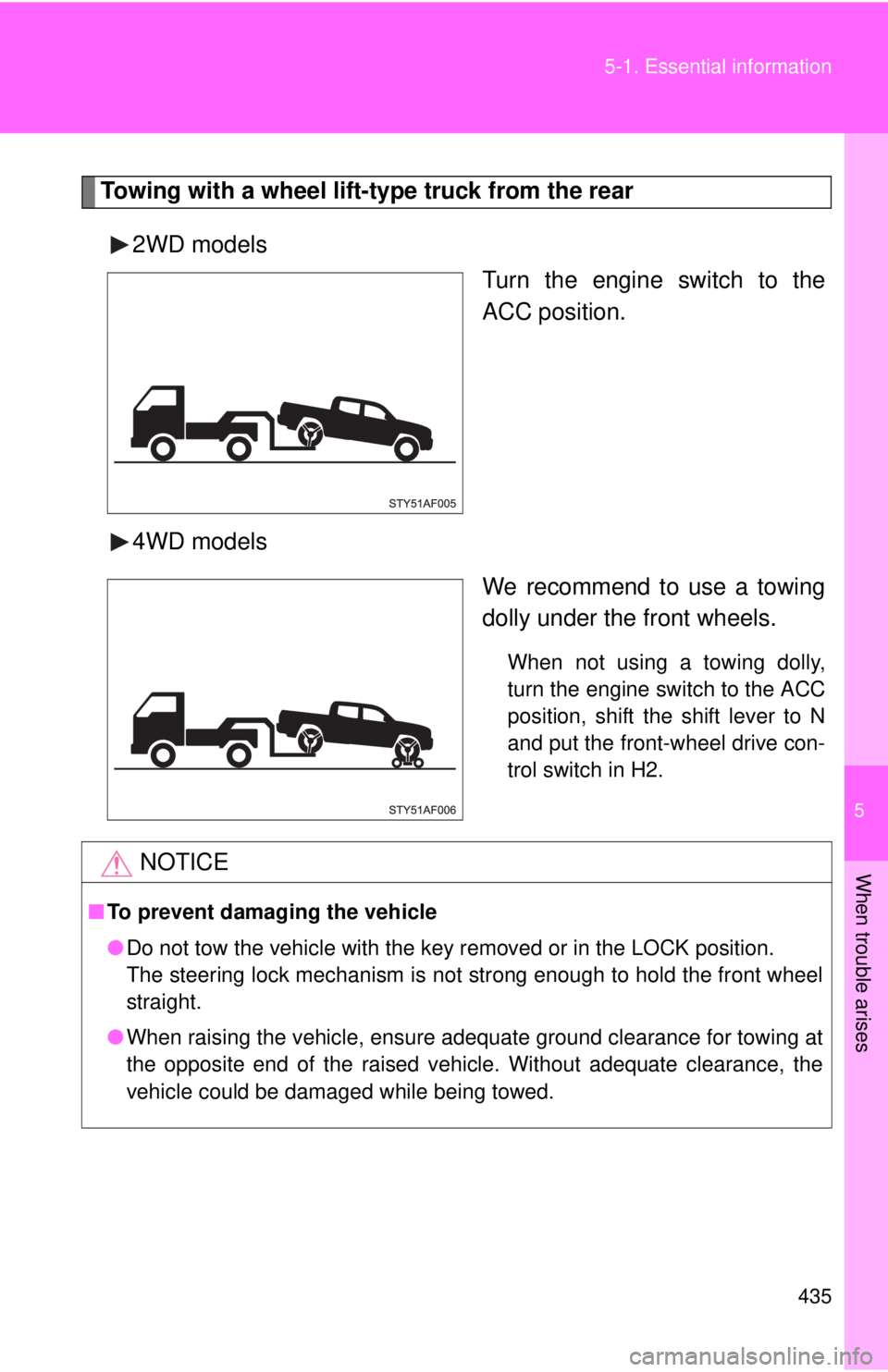
5
When trouble arises
435
5-1. Essential information
Towing with a wheel lift-type truck from the rear
2WD models Turn the engine switch to the
ACC position.
4WD models We recommend to use a towing
dolly under the front wheels.
When not using a towing dolly,
turn the engine switch to the ACC
position, shift the shift lever to N
and put the front-wheel drive con-
trol switch in H2.
NOTICE
■To prevent damaging the vehicle
●Do not tow the vehicle with the key removed or in the LOCK position.
The steering lock mechanism is not strong enough to hold the front wheel
straight.
● When raising the vehicle, ensure adequate ground clearance for towing at
the opposite end of the raised vehicle. Without adequate clearance, the
vehicle could be damaged while being towed.
Page 498 of 548
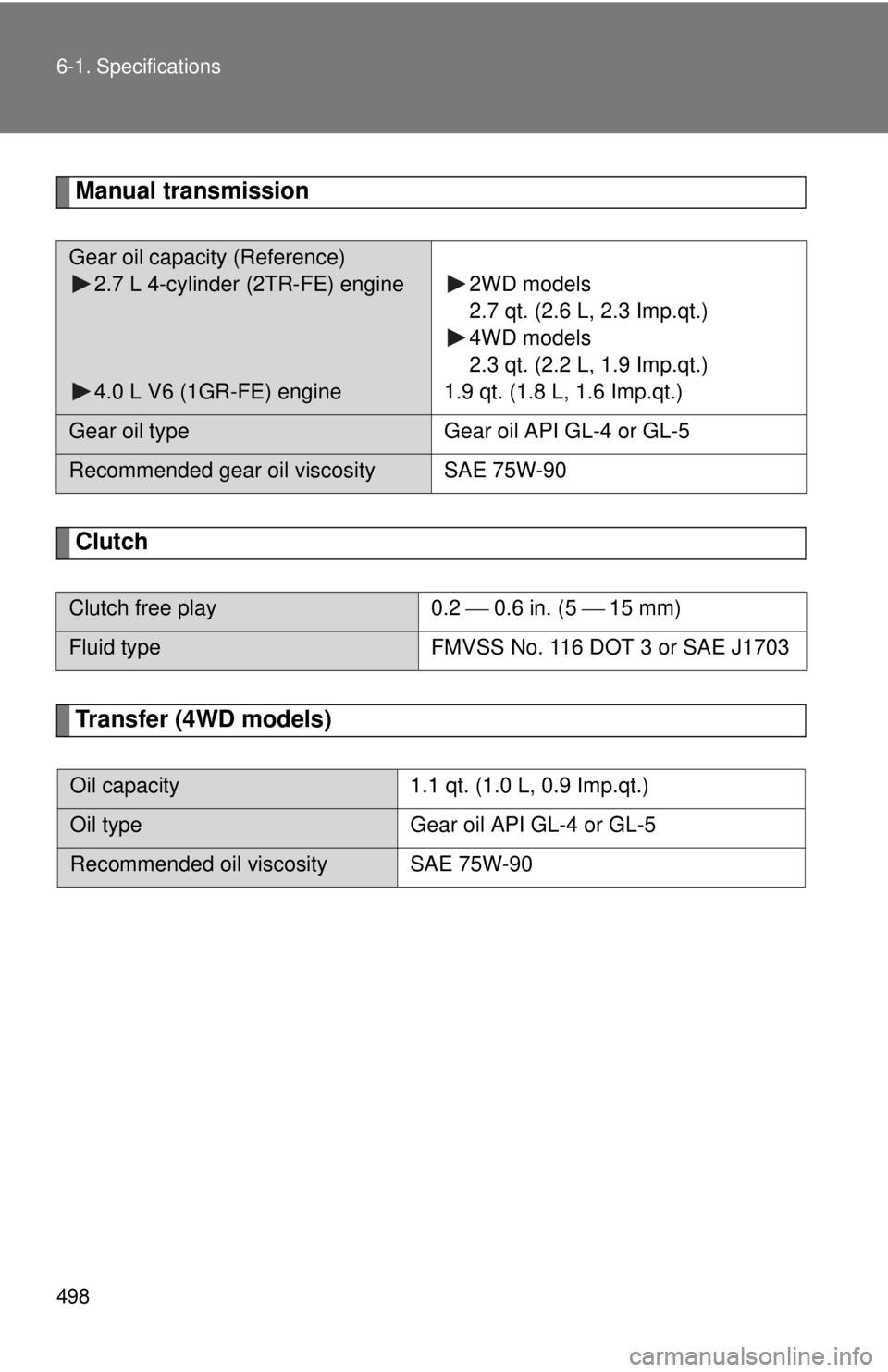
498 6-1. Specifications
Manual transmission
Clutch
Transfer (4WD models)
Gear oil capacity (Reference)2.7 L 4-cylinder (2TR-FE) engine
4.0 L V6 (1GR-FE) engine 2WD models
2.7 qt. (2.6 L, 2.3 Imp.qt.)
4WD models
2.3 qt. (2.2 L, 1.9 Imp.qt.)
1.9 qt. (1.8 L, 1.6 Imp.qt.)
Gear oil type Gear oil API GL-4 or GL-5
Recommended gear oil viscosity SAE 75W-90
Clutch free play0.2 0.6 in. (5 15 mm)
Fluid type FMVSS No. 116 DOT 3 or SAE J1703
Oil capacity1.1 qt. (1.0 L, 0.9 Imp.qt.)
Oil typeGear oil API GL-4 or GL-5
Recommended oil viscosity SAE 75W-90
Page 515 of 548
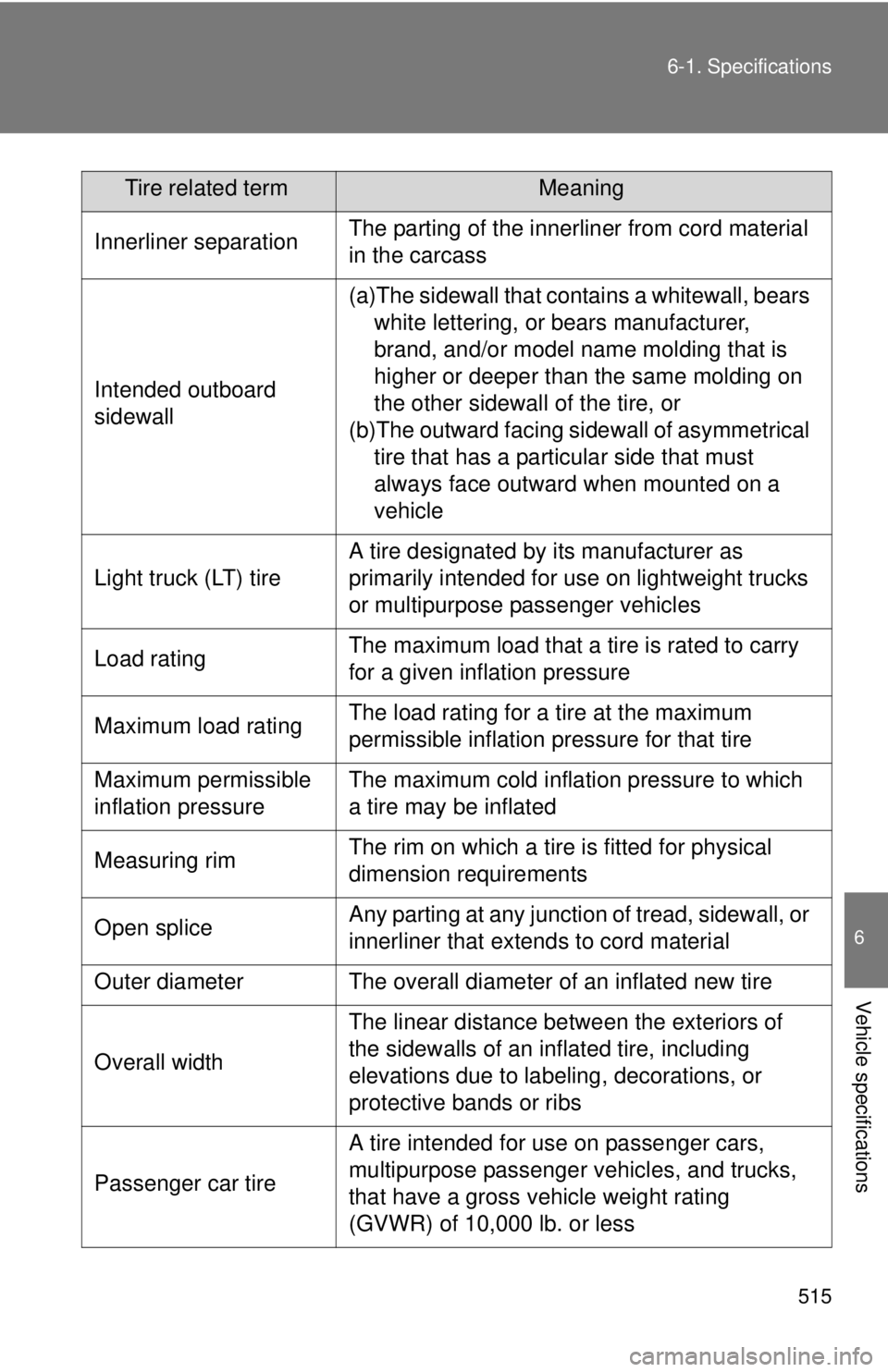
515
6-1. Specifications
6
Vehicle specifications
Innerliner separationThe parting of the innerliner from cord material
in the carcass
Intended outboard
sidewall
(a)The sidewall that cont
ains a whitewall, bears
white lettering, or bears manufacturer,
brand, and/or model name molding that is
higher or deeper than the same molding on
the other sidewall of the tire, or
(b)The outward facing sidewall of asymmetrical tire that has a particular side that must
always face outward when mounted on a
vehicle
Light truck (LT) tire
A tire designated by its manufacturer as
primarily intended for use on lightweight trucks
or multipurpose passenger vehicles
Load ratingThe maximum load that a tire is rated to carry
for a given inflation pressure
Maximum load ratingThe load rating for a tire at the maximum
permissible inflation pressure for that tire
Maximum permissible
inflation pressureThe maximum cold inflation pressure to which
a tire may be inflated
Measuring rimThe rim on which a tire is fitted for physical
dimension requirements
Open spliceAny parting at any junction of tread, sidewall, or
innerliner that extends to cord material
Outer diameterThe overall diameter of an inflated new tire
Overall width
The linear distance between the exteriors of
the sidewalls of an inflated tire, including
elevations due to labeling, decorations, or
protective bands or ribs
Passenger car tire
A tire intended for use on passenger cars,
multipurpose passenger vehicles, and trucks,
that have a gross vehicle weight rating
(GVWR) of 10,000 lb. or less
Tire related termMeaning
Page 525 of 548
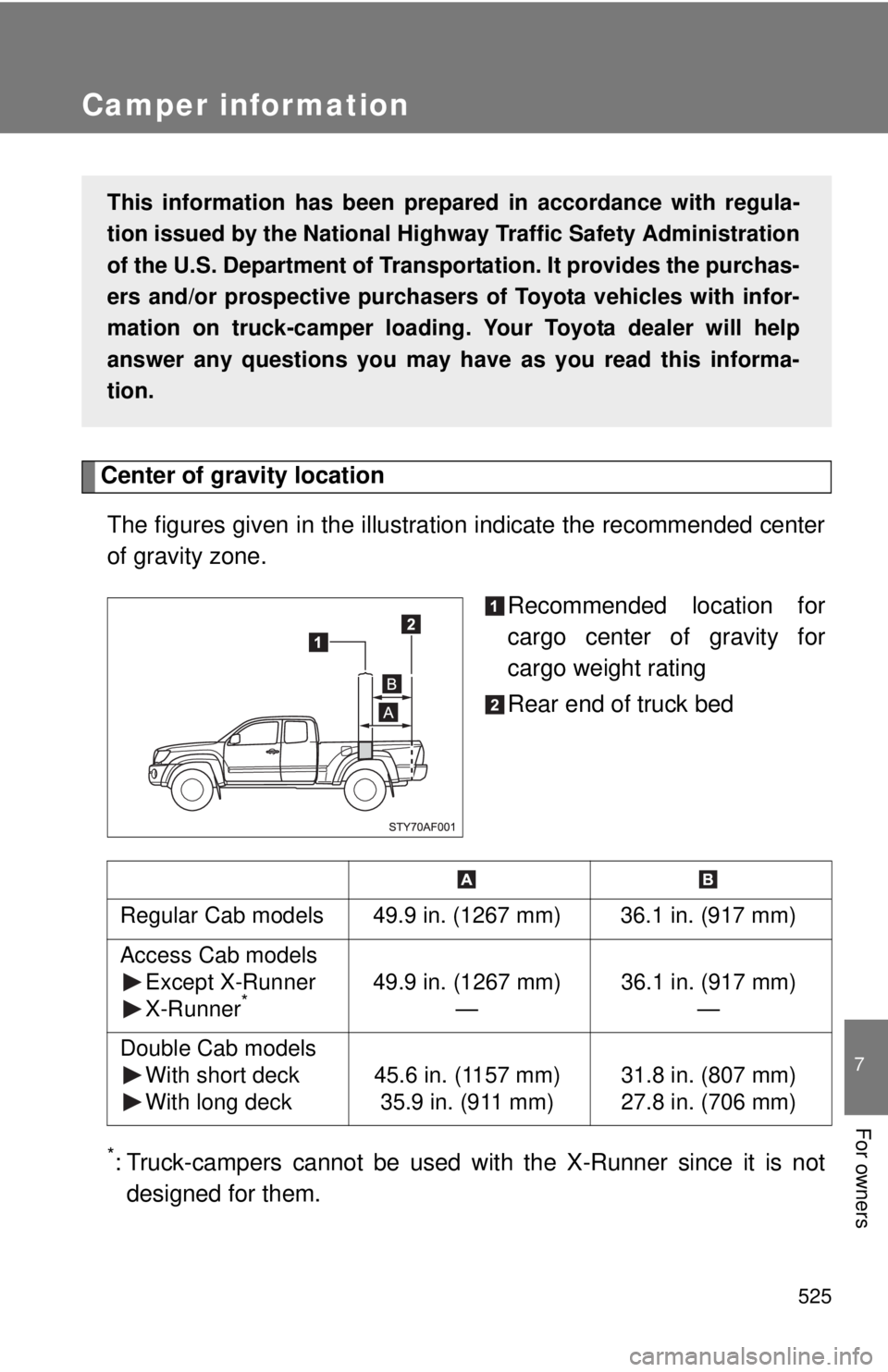
525
7
For owners
Camper information
Center of gravity locationThe figures given in the illustration indicate the recommended center
of gravity zone. Recommended location for
cargo center of gravity for
cargo weight rating
Rear end of truck bed
*: Truck-campers cannot be used with the X-Runner since it is not
designed for them.
This information has been prepared in accordance with regula-
tion issued by the National Highway Traffic Safety Administration
of the U.S. Department of Transportation. It provides the purchas-
ers and/or prospective purchasers of Toyota vehicles with infor-
mation on truck-camper loading. Your Toyota dealer will help
answer any questions you may have as you read this informa-
tion.
Regular Cab models 49.9 in. (1267 mm) 36.1 in. (917 mm)
Access Cab models Except X-Runner
X-Runner
*49.9 in. (1267 mm) — 36.1 in. (917 mm)
—
Double Cab models With short deck
With long deck 45.6 in. (1157 mm)
35.9 in. (911 mm) 31.8 in. (807 mm)
27.8 in. (706 mm)
Page 526 of 548
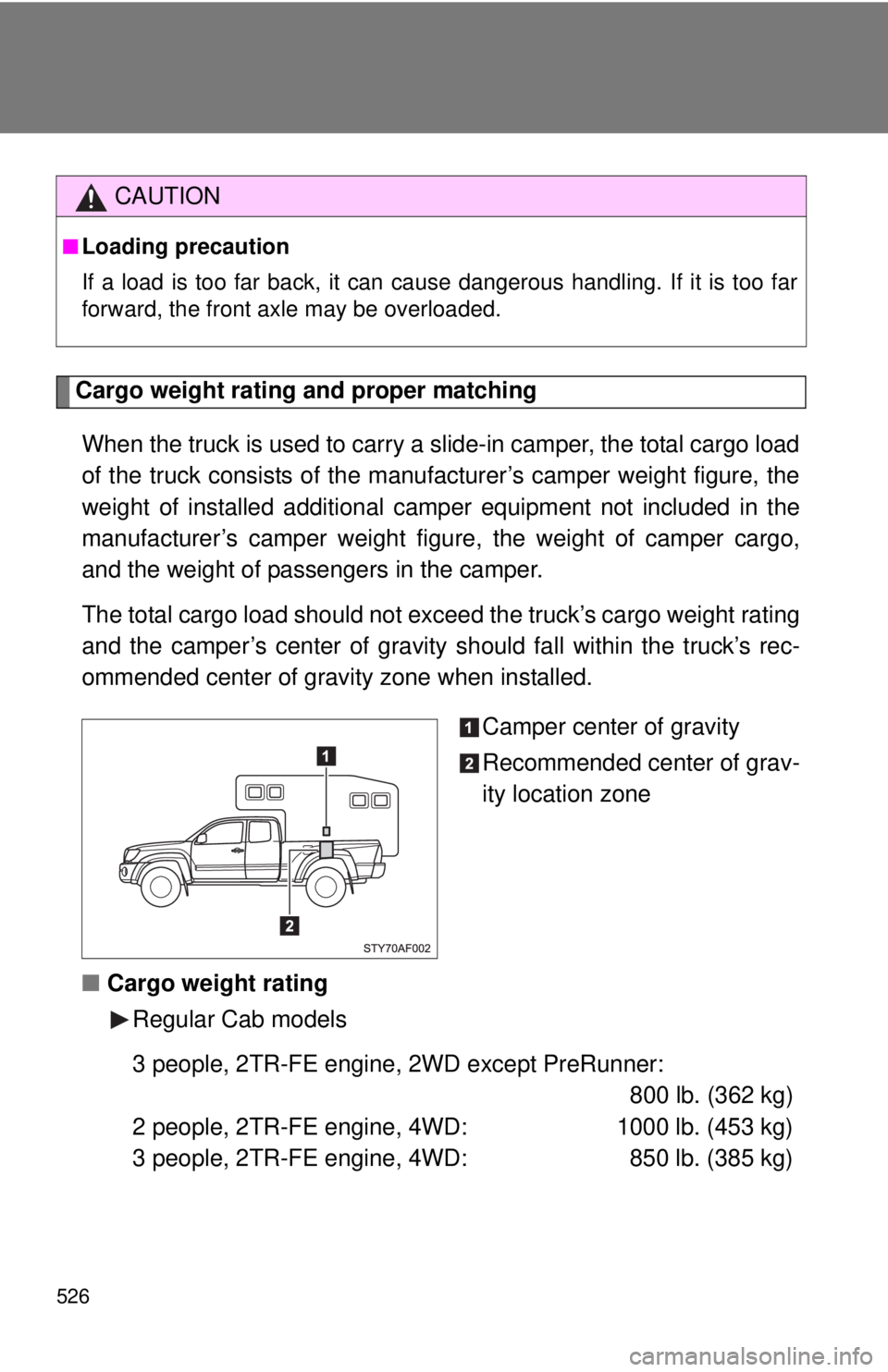
526
Cargo weight rating and proper matchingWhen the truck is used to carry a slide-in camper, the total cargo load
of the truck consists of the manufacturer’s camper weight figure, the
weight of installed additional camper equipment not included in the
manufacturer’s camper weight figu re, the weight of camper cargo,
and the weight of passengers in the camper.
The total cargo load should not exceed the truck’s cargo weight rating
and the camper’s center of gravity should fall within the truck’s rec-
ommended center of gravity zone when installed.
Camper center of gravity
Recommended center of grav-
ity location zone
■ Cargo weight rating
Regular Cab models
3 people, 2TR-FE engine, 2WD except PreRunner: 800 lb. (362 kg)
2 people, 2TR-FE engine, 4WD: 1000 lb. (453 kg)
3 people, 2TR-FE engine, 4WD: 850 lb. (385 kg)
CAUTION
■Loading precaution
If a load is too far back, it can cause dangerous handling. If it is too far
forward, the front axle may be overloaded.